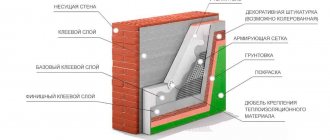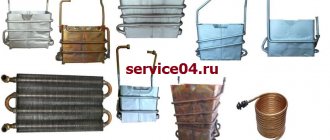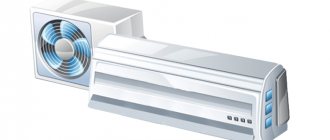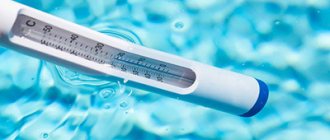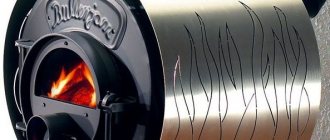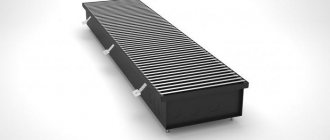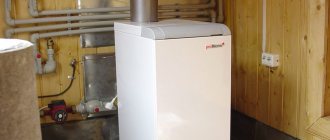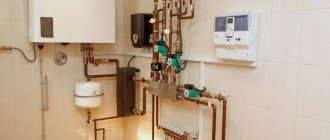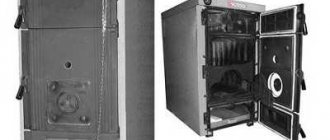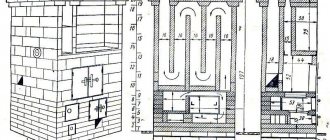Purpose
Heat exchangers are devices used to transfer energy between two fluids at different temperatures. They improve energy efficiency because the energy from threads already in the system can be transferred to another part of the process rather than simply wasted. In the new era of sustainable development, the growing pressure to save energy and reduce overall environmental impact has placed greater emphasis on the use of heat exchangers with higher thermal efficiency. In this new scenario, the plate heat exchanger can play an important role.
Story
Plate heat exchangers were first introduced in 1923 for the pasteurization of milk, but are now used in many applications in the chemical, petroleum, climate control, refrigeration, dairy, pharmaceutical, food and medical industries. This is due to their unique advantages such as flexible thermal design (plates can simply be added or removed to meet different thermal or processing requirements), ease of cleaning to maintain strict hygienic conditions, good temperature control (necessary in cryogenic processes) and better heat transfer characteristics.
Types of plate heat exchangers
A plate heat exchanger (PHE) is a compact type of heat exchanger that uses a series of thin plates to transfer heat between two fluids. There are four main types of PT:
- collapsible,
- soldered,
- welded
- semi-welded.
A plate collapsible heat exchanger is a device in which the main function of heat transfer between coolants is performed by a stack of plates. The media do not mix with each other thanks to the alternation of plates with dense rubber gaskets, which form two movement circuits (Figure 1).
Figure 1 – Typical plate heat exchanger
This type of unit received its name “collapsible” because the package of plates is not only assembled, but also disassembled during regular maintenance (washing) or repairs.
Plate heat exchanger
| After the required package of plates has been assembled, tie rods (8) with centering washers and nuts (9) are inserted into special side grooves on the main and pressure plates. Next, by alternately tightening the nuts on the studs, as indicated in the operating instructions, we tighten the plate pack to a certain size. Assembly of LHE heat exchangers is carried out by qualified personnel who have been trained and have sufficient work experience |
Design of a gasketed heat exchanger
The gasketed heat exchanger consists of the following elements:

Figure 2 – Design of a plate heat exchanger
PT consists of:
- a package of thin rectangular plates with holes through which two fluid streams flow, where heat transfer occurs. The heat exchanger plates, made of stainless steel or titanium, are pressed against each other using sealing gaskets. The number of plates depends on the technical parameters and equipment requirements.
- frame plate ( fixed pressure plate ),
- a pressure plate ( movable pressure plate ) presses the entire package against a stationary pressure plate using fastening elements: tightening bolts, bearings, lock washers.
- load-bearing base - a guide beam onto which the plates are placed during assembly of the unit.
- support frame - a vertical element to which guide beams (upper and lower load-bearing beams) are attached.
- upper and lower rods and screws for compressing the plate pack.
By the way, read this article too: Welded plate heat exchanger (Block)
A custom plate heat exchanger can accommodate up to 700 plates. When the plate stack is compressed, the holes in the corners of the plates form continuous tunnels or manifolds through which fluids pass as they cross the plate pack and exit the equipment. The spaces between the thin plates of the heat exchanger form narrow channels that alternate between hot and cold fluids and provide little resistance to heat transfer.
How to choose a plate heat exchanger for your home?
It depends on where you plan to use it.
If you are, for example, choosing a plate heat exchanger for a fireplace or stove, you should first check the power with which it operates and what systems can be connected to it.
If, for example, you plan to connect a gas furnace with a water jacket, which is also part of a heating system using panel radiators, you should choose a plate heat exchanger of a very robust design, with a large number of plates (about 30) and high parameters responsible for its performance ( e.g. maximum temperature).
There will be slightly lower requirements for exchangers if your furnace has a power of up to 15 kW or a limited underfloor heating system. Also, let’s not forget about the operating conditions of the exchanger, which may differ.
What is the essence of a mortgage (loan) secured by real estate?
Your own house on Rublyovka. Is it real?
Half-timbered houses. Features of the half-timbered style. Advantages and disadvantages
Lighting the hallway in the house. How to make the hall brighter?
Grill area on site. How to do it better? Advantages and disadvantages of different solutions
How to level a floor under tiles using special mixtures?
Delays in deadlines and delay in delivery of the village by the developer. What to do?
Should you decorate your house with siding?
Interior designs for a bedroom in a country house
Tax on country houses. How much do you need to pay for buildings on plots?
Typical plates and gaskets
Plates
The most important and most expensive part of the FET is its thermal plates, which are made of metal, metal alloy or even special graphite materials, depending on the application.
Examples of PT materials commonly found in industrial applications:
- stainless steel,
- titanium,
- nickel,
- aluminum,
- incoloy,
- Hastelloy,
- Monel,
- tantalum.
The plates can be flat, but in most cases they have corrugations, which have a strong influence on the thermal-hydraulic characteristics of the device. Some of the basic plate types are shown in Figure 3, although most modern PTs use chevron plate types.

Figure 3 - Typical categories of plate corrugations: (a) washboard, (b) zigzag, (c) chevron or herringbone, (d) ridges and recesses, (e) washboard with secondary corrugations, (f) oblique washboard.
Channels formed between adjacent plates create a swirling motion for fluids, as seen in Figure 4.
Figure 4 – Turbulent flow in the channels of a plate heat exchanger
The chevron angle is reversed in adjacent sheets so that when the plates are tightened, the corrugations provide multiple contact points that support the hardware. The compaction of the plates is achieved by gaskets installed around the perimeter.
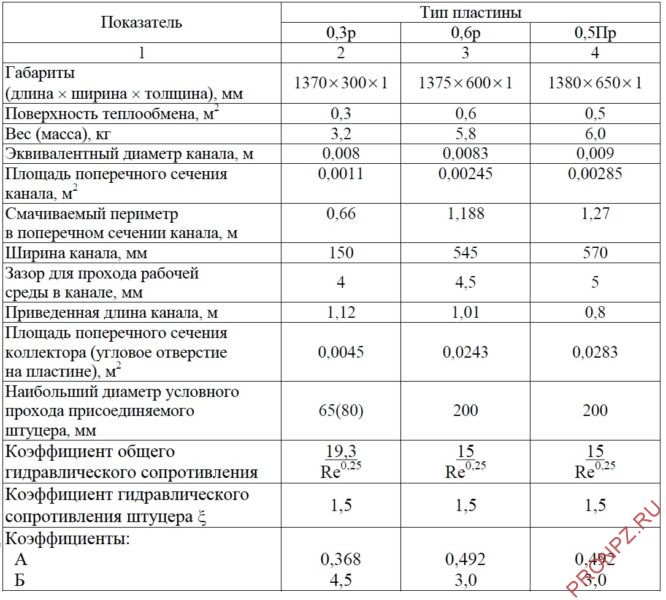
Figure 5 - Technical characteristics of the plates
Gaskets
Gaskets are typically molded elastomers selected based on their fluid compatibility and temperature and pressure conditions. Multi-pass devices can be implemented depending on the arrangement of spacers between the plates. Butyl or nitrile rubbers are materials commonly used in the manufacture of gaskets.
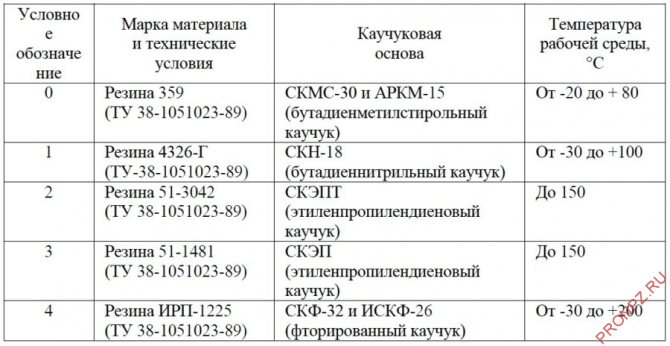
Figure 6 - Technical characteristics of gaskets
Seals
The seal is the most vulnerable point of a plate heat exchanger. LHE is a leader in the production of rubber seals for heat exchangers in a variety of applications. Using our own developments and extensive experience allows us to offer our customers heat exchangers with very high-quality seals.
In our own laboratories we develop the latest types of seals and comprehensively check the quality of our gaskets.
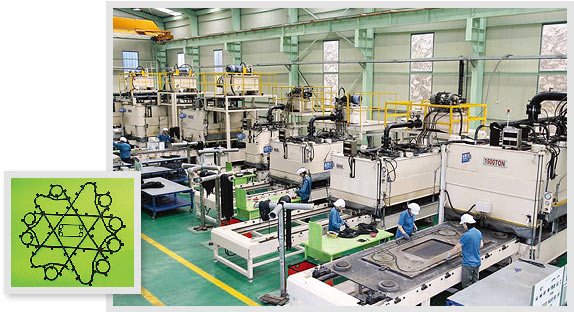
All seals are marked as shown in the figure, so that the type of seal can be visually determined at the Customer's site without searching for accompanying documentation.
The table shows the main properties of LHE plate heat exchanger seals.

Flow patterns in a plate heat exchanger
Single pass circuit
The simplest plate heat exchanger designs are those in which both fluids make only one pass, so there is no change in flow direction. These are known as 1-1 single pass designs and there are two types: counterflow and parallel. The big advantage of the single-pass arrangement is that the fluid inlets and outlets can be installed in a fixed plate, allowing the equipment to be easily opened for maintenance and cleaning without disturbing the piping. This is the most widely used single-pass design, known as a U-arrangement. There is also a single-pass Z design, which has fluid inlet and outlet through both end plates (Figure 9).

Figure 9 – Mechanism of operation of a single-pass PT: a) U-shaped arrangement and B) Z-shaped arrangement.
Countercurrent flow, where the streams flow in opposite directions, is usually preferred due to the achievement of higher thermal efficiency, compared to parallel flow, where the streams flow in the same direction.
By the way, read this article too: Welded plate heat exchanger (Block)
Multi-pass scheme
Multi-pass devices can also be used to increase heat transfer or flow rates of streams and are usually required when there is a significant difference between stream rates (Figure 10).

Figure 10 – Multi-pass plate heat exchanger
DC plates can provide vertical or diagonal flow, depending on the location of the gaskets. For vertical flow, the inlet and outlet of a given flow are located on the same side of the heat exchanger, while for diagonal flow they are on opposite sides. Assembling a stack of plates involves alternating plates “a” and “b” for the corresponding flows. Mounting the plate stack in vertical flow mode only requires the appropriate shim configuration since devices A and B are equivalent (they rotate 180° as shown in Figure 11a). This is not possible in the case of diagonal flow, which requires both types of mounting plates (Figure 11b). Poor flow distribution is more likely to occur in a vertical flow array.

Figure 11 – (a) plate with vertical flow, (b) plate with diagonal flow
Principle of operation
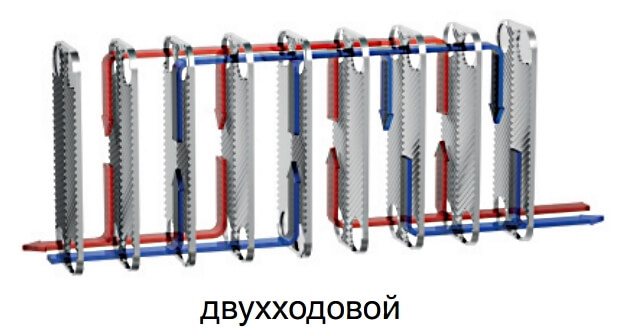
Operating principle of two-pass heat exchanger
The operating principle of a plate heat exchanger cannot be called simple. The plates are installed at an angle of 180 degrees relative to each other. Usually this is a soldering of two pairs of plates that provide input and output of thermal energy. The outermost pair does not participate in the heat exchange process.
Depending on the design features, heat exchangers are usually divided into three types:
- single-circuit,
- multi-circuit,
- two-way.
The circulation of thermal energy in a single-circuit device is carried out permanently, throughout the entire circuit and in one direction, with a simultaneous counterflow of coolant.
The movement of the coolant in multi-circuit equipment occurs in different directions. Such devices are used only if there is a slight difference in temperature in the return and incoming flows.
The movement of thermal energy in two-pass devices occurs along two independent circuits, subject to constant monitoring of the heat supply.
There is another type of device - a steam plate heat exchanger, which is responsible for heating water or other liquid in the heating system. The operating principle of this device is no different from standard models of plate units.
Advantages and disadvantages
Advantages
- Flexibility: Simple disassembly allows the PT to be adapted to new process requirements by simply adding or removing plates, or changing the number of passes. In addition, the variety of plate corrugation models available, together with the ability to use combinations of them in the same FET, means that different block conformations can be tested during optimization procedures.
- Good temperature control: thanks to the narrow channels formed between adjacent plates, the PT contains only a small volume of liquid. In this way, the device responds quickly to changes in process conditions with short lag times so that the temperature is easily controlled. This is important when high temperatures need to be avoided. In addition, the shape of the channels reduces the possibility of stagnant zones (dead space) and overheating zones.
- Low cost of production: Because the plates are only pressed (or glued) together rather than welded, PTs can be relatively inexpensive to produce. Special materials may be used to make the plates to make them more resistant to corrosion and/or chemical reactions.
- Efficient Heat Transfer: Plate corrugations and small hydraulic diameter enhance the generation of turbulent flow so that high heat transfer rates can be achieved for liquids. Consequently, up to 90% of the heat can be recovered, compared to only 50% in the case of shell-and-tube heat exchangers.
- Compact: The high thermal efficiency of PTs means that they have a very small footprint. For the same heat transfer area, PTs can often occupy 80% less area (sometimes 10 times less) than shell-and-tube heat exchangers (Figure 7).
- Fouling Reduction: Fouling reduction occurs as a result of a combination of high turbulence and short fluid residence time. Correction factors for contamination for heat exchangers can be tens of times lower than for shell-and-tube heat exchangers.
- Easy to Inspect and Clean: Because PHE components can be separated, all parts that are exposed to liquids can be cleaned and inspected. This feature is essential in the food and pharmaceutical industries.
- Easy leak detection: Gaskets have vent holes (Figure 8) that prevent fluids from mixing in the event of a failure, which also makes leak detection easier.
By the way, read this article too: Welded plate heat exchanger (Block)

Figure 7 - Illustration of the typical size difference between a PT and a shell-and-tube heat exchanger for a given heat load

Figure 8 - Ventilation channels in gaskets to detect possible leaks
Flaws
- Temperature and Pressure Limitations: An important limitation of PT is related to plate gaskets. Pressure and temperature exceeding 25 atm and 160 °C respectively are unacceptable as they may cause standard gaskets to leak. However, the gaskets, made from special materials, can withstand temperatures up to 400 °C, and it is possible to weld or solder the plates to each other to work in more severe conditions. This would have the added benefit of increasing operating limits as well as the ability to handle corrosive fluids as it would eliminate the need for gaskets. However, the PT will lose its main advantages of flexibility and ease of cleaning, and the equipment will become more expensive.
- High pressure drop: Due to the corrugated plates and the small flow space between them, the pressure drop due to friction is high, increasing pumping costs. Pressure drop can be reduced by increasing the number of passes per pass and dividing the flow into more channels. This reduces the flow velocity in the channel, hence reducing the coefficient of friction. However, the convective heat transfer coefficient also decreases, which reduces the efficiency of the heat exchanger.
- Phase Change: In special cases, PTs can be used in condensation or evaporation operations, but are not recommended for gases and vapors due to limited space within the channels and pressure limitations.
- Fluid Types: Processing fluids that are highly viscous or contain fibrous material is not recommended due to high pressure drop and flow distribution issues within the PT. Compatibility between the fluid and gasket material should also be considered. Flammable or toxic liquids should be avoided due to the possibility of leakage.
- Leakage: Friction between metal plates can cause wear and small holes that are difficult to detect. As a precaution, it is recommended that the process fluid be pressurized to reduce the risk of contamination if the plate leaks.
Do I need to buy a plate heat exchanger? What does it give?
These devices are widely used in industry. They are used in central heating systems, air conditioning systems, and in the construction of commercial and residential buildings.
The design of a plate heat exchanger is based mainly on two circuits between which heat exchange occurs. Their work can be illustrated by the example of the operation of a boiler and radiators (batteries). One circuit has thermal energy coming from a high pressure system (boiler) that is transferred to a low pressure system where the temperature is lower (radiator). In this way, heat is transferred to the final device.
Do you need a plate heat exchanger for a private home? The answer seems obvious - this equipment will improve the operation of the entire heating system, which includes individual devices.
At the same time, it should also be emphasized that the plate heat exchanger is not the only such solution available on the market. Homeowners can also use so-called surface pipes, but they are not universally applicable. In their case, first of all, we are dealing with lower efficiency, which is associated with a lower heat transfer coefficient.
So if you want to improve your home's heating efficiency, consider using plate heat exchangers. You will be able to noticeably feel how the batteries will heat up better with lower boiler loads and lower electricity bills. Moreover, modern models of heat exchangers are not as bulky as before, they are compact and have a design that is pleasing to the eye. Moreover, they are completely resistant to corrosion, so they can serve us for a very long time.
